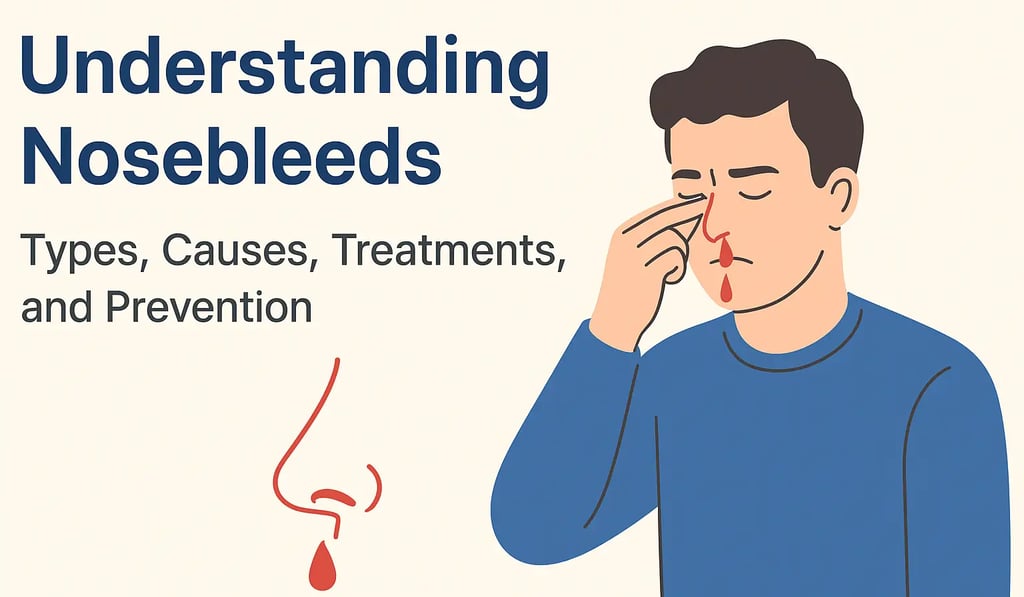Nosebleeds Explained: Types, Causes, Treatments, and Prevention
Learn everything about nosebleeds (epistaxis) – their types, common causes, effective treatments, and prevention tips. Understand when to manage at home and when to seek medical help.


What Are Nosebleeds (Epistaxis)?
Nosebleeds, medically known as epistaxis, occur when blood vessels inside the nose rupture. Although they can be alarming, most nosebleeds are not serious and can be managed at home. They are often triggered by environmental factors, injuries, or underlying health conditions.
Understanding the types, causes, and treatments of nosebleeds can help you respond effectively and know when to seek medical care.
Types of Nosebleeds
Nosebleeds are classified into two main types:
🔹 Anterior Nosebleeds
The most common type, making up the majority of cases.
Originate from the front part of the nasal septum, which contains delicate blood vessels.
Often caused by dry air, allergies, frequent nose blowing, or nose picking.
Usually appear as bleeding from one or both nostrils.
Easier to manage with simple first aid.
🔹 Posterior Nosebleeds
Less common but often more severe.
Originate from deeper nasal structures and involve larger blood vessels.
Blood may flow into the throat or mouth, leading to heavier bleeding.
Typically require medical intervention and are harder to control at home.
Common Causes of Nosebleeds
Several factors can contribute to nosebleeds, including:
Environmental Triggers – Dry air, heated rooms, and low humidity dry out nasal membranes.
Allergies – Dust, pollen, and pet dander can irritate nasal passages.
Injuries – Accidents, sports injuries, or frequent nose picking damage delicate blood vessels.
Medical Conditions – Hypertension, clotting disorders, or infections may increase risk.
Medications – Blood thinners or drugs that affect clotting can make nosebleeds more frequent.
Understanding these causes helps in prevention and effective management.
Effective Treatments for Nosebleeds
Most nosebleeds can be managed with simple first-aid steps:
Sit upright and lean slightly forward (to prevent blood from entering the throat).
Pinch the soft part of the nose with your thumb and index finger for 10–15 minutes.
Apply a cold compress to the bridge of the nose to constrict blood vessels.
Stay calm and avoid lying flat or tilting your head back.
When to Seek Medical Help
Seek immediate care if:
Bleeding lasts longer than 20 minutes.
The nosebleed follows a serious injury.
There is heavy blood loss or blood flowing down the throat.
Medical treatments may include nasal packing, cauterization, or prescribed medications.
Preventing Nosebleeds: Tips and Best Practices
Preventive measures can reduce the risk of recurring nosebleeds:
Maintain Indoor Humidity – Use a humidifier (30–50% humidity recommended).
Use Saline Sprays – Keep nasal passages moist, especially in dry environments.
Avoid Trauma – Do not pick or blow your nose too forcefully.
Manage Allergies – Use antihistamines or prescribed sprays under medical guidance.
Monitor Health Conditions – Control blood pressure and clotting disorders with regular check-ups.
By following these steps, you can significantly lower the chances of nosebleeds and improve overall nasal health.
✅ Conclusion
Nosebleeds (epistaxis) are common and usually harmless, but understanding their types, causes, treatments, and prevention is essential. While anterior nosebleeds can often be managed at home, posterior nosebleeds may require professional care.
Taking preventive measures like humidifying your environment, avoiding nasal trauma, and managing health conditions can help you minimize episodes. Always seek medical help if bleeding is heavy, persistent, or linked to an injury.
